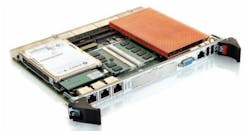PMC module with low-latency, dual-channel H.264 encoder introduced by AMP for UAVs and video surveillance
NEW YORK, 22 Nov. 2011. Advanced Micro Peripherals in New York is introducing the H264-ULL-PMC low-latency, dual-channel H.264 encoder on a PCI Mezzanine Card (PMC) for time-critical applications in real-time control, unmanned aerial vehicles (UAVs) and other defense applications, transportation, traffic monitoring and control, video digital recording and internet streaming, electronic news gathering, simulation, and remote video surveillance.The H264-ULL-PMC can capture and compress as many as two analog video inputs of resolutions as fine as 1,080 pixels to the H.264/MPEG-4 AVC (Part 10) standard. The card offers latency shorter than 40 microseconds, and can be configured for a range of bandwidth and storage requirements.The H264-ULL-PMC has two analog HD video input channels. Each channel can be independently configured for analog YPbPr HD, analog RGsB (sync on green) or analog VGA (separate HSync, VSync). This H264 encoder card also is available with extended temperature range options of -40 to 85 degrees Celsius. Software support includes Windows, Linux, and QNX.
For more information contact Advanced Micro Peripherals online at www.amp-usa.com.
Related stories
3U VPX carrier cards for interfacing PMC and XMC cards to VPX embedded computing systems introduced by Acromag
PMC cards based on Xilinx Spartan-6 FPGA introduced by Acromag for signal processing applications
MIL-STD-1553 avionics databus interface packaged on a PMC module introduced by DDC.
